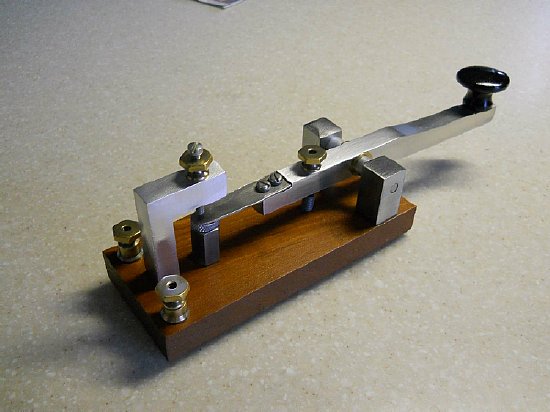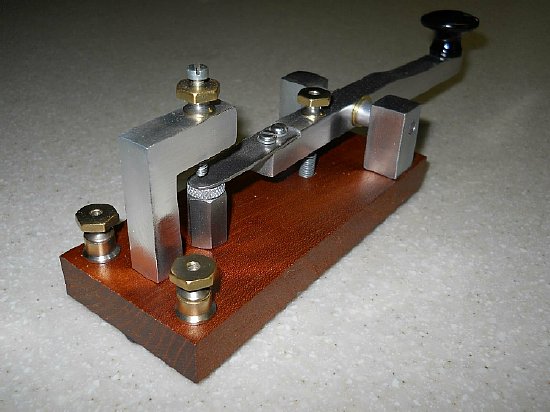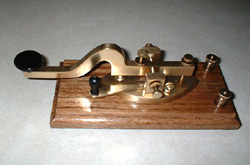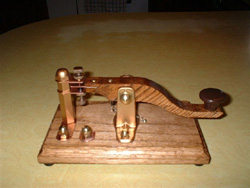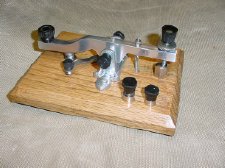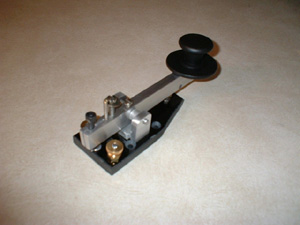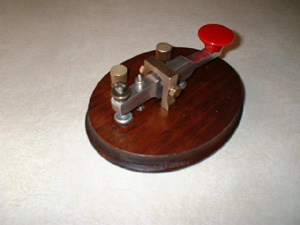Ed,
NS3E's
Latest
Key Projects
NOTICE: Refresh and
reload this page for lastest projects.

NS3E Photo October 2015
THIS KEY IS KNOWN AS THE VERTICAL VIBROPLEX OR “WIRE CHIEF.” ANYONE COULD OBTAIN ONE, IF THEY WANTED, BUT THEY WERE MADE WITH RAILROAD STATION MANAGERS IN MIND. EARLY RAILROAD TELEGRAPHERS USED STRAIGHT KEYS, BUT CARPAL SYNDRONE WAS A PROBLEM AND DIFFERENT ATTEMPTS WERE MADE TO CORRECT THE DISABLING FACTOR. BUGS WERE INVENTED TO MAKE SENDING EASIER, AND SOON MOST ALL RAILROAD OPERATORS HAD ONE. MOST EVERY RAILROAD STATION HAD 3 OR 4 TELEGRAPHERS EMPLOYED AND A STATION MANAGER. STATION MANAGERS USED THE WIRE CHIEFS BECAUSE THEY TOOK UP LESS SPACE ON HIS SMALLER DESK.

NS3E Photo October 2015
A FELLOW COLLECTOR FRIEND OF MINE LIVED IN MISSOURI NOT FAR FROM THE “CEDAR RAPIDS BUG” MANUFACTURING CO. THEY WENT OUT OF BUSINESS AND MY FRIEND WAS FORTUNATE ENOUGH TO GET A LARGE QUANTITY OF PARTS THAT WERE USED IN THEIR BUG MANUFACTURE. HE SENT ME A NICE GOODY BAG OF PARTS KNOWING THEY WOULD BE PUT TO GOOD USE.
A VERTICAL BUG IS BASICALLY THE SAME AS A HORIZONTAL ONE BUT TAKES UP LESS SPACE. THEY ALSO HAVE A CERTAIN MYSTIC QUALITY AND ARE MUCH SOUGHT AFTER BY COLLECTORS. VIBROPLEX, THE ORIGINATOR, ONLY PRODUCED THEM FROM 1917 TO 1919. THE ORIGINAL WIRE CHIEFS HAD A HEAVY IRON, “U” SHAPED BASE TO HOLD THE KEY UPRIGHT WITHOUT TOPPLING OVER.
I MADE THIS KEY USING PARTS FROM MY “CEDAR RAPIDS” PARTS COLLECTION, AND FABRICATED PARTS OF MY OWN. THE BACKBOARD IS ¼” PLASTIC STOCK AND THE HEAVY BASE IS QUITE UNIQUE. SOMEWHERE, A MACHINEST TOOK A SECTION OF HEAVY RAILROAD RAIL AND CUT OUT BREAD SLICE TYPE PIECES. I USED ONE OF THE SLICES AS A BASE FOR THIS KEY. SO NOW, YOU HAVE A STATION MANAGER TYPE KEY MOUNTED ON A REAL SECTION OF RAILROAD RAIL. THE VIBRATING PENDULUM SHAFT IS LONGER THAN NORMAL TO SLOW DOWN THE SPEED OF THE KEY QUITE A BIT. NS3E
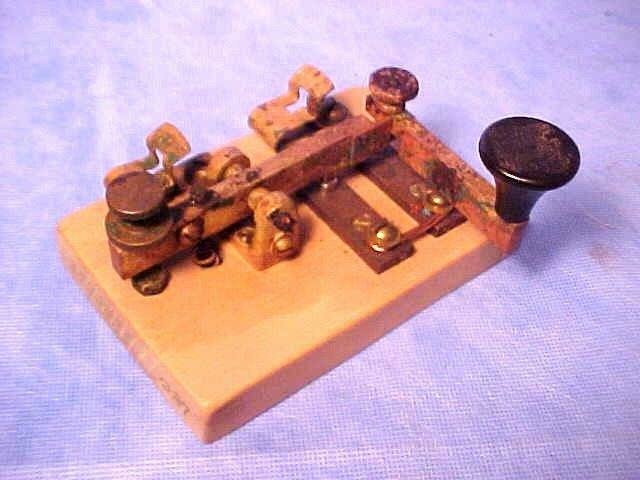
Original owner photo.
J-3 WWI Telegraph Key Restoration Project by NS3E.
The photo above is the key as delivered to me. The J-3 was a key used in a WW1 telegraph box and the long lever had to be folded to close the lid. When extended, you will notice that the lever is quite long, making it similar to the Swedes. The previous owner retained a picture of it on his website and declared it was for display only and not workable. Here are three pictures of the restored J-3 basket case as well as the key before restoration. These keys are semi-rare and command good prices where and when they show up. I paid little for this key and I knew it was a basket case, but was surprised to find out just how bad. The 3 indicates 1903 and it undoubtedly had sat out in the elements for many years. Just about all working parts were solidly frozen and I had to use a torch to free them. Even at that, the main part of the lever snapped off and I had to fabricate a new one All the parts that you see are original except the thumb knobs, several screws, and the main section of the lever. Notice the big Fahnestsock line clips
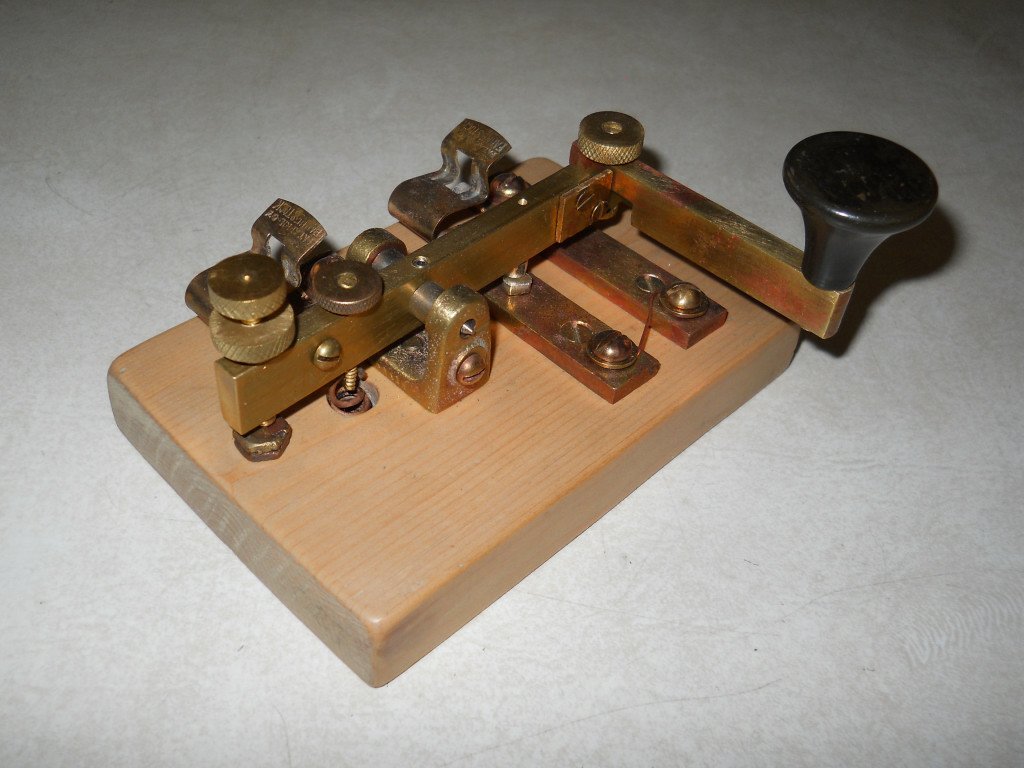
Sept 2015 NS3E Photo
J-3 key after restoration. Just about all working parts were solidly frozen and I had to use a torch to free them. Even at that, the main part of the lever snapped off and I had to fabricate a new one All the parts that you see are original except the thumb knobs, several screws, and the main section of the lever. Just about all working parts were solidly frozen and I had to use a torch to free them. Even at that, the main part of the lever snapped off and I had to fabricate a new one All the parts that you see are original except the thumb knobs, several screws, and the main section of the lever. Notice the big Fahnestsock line clips
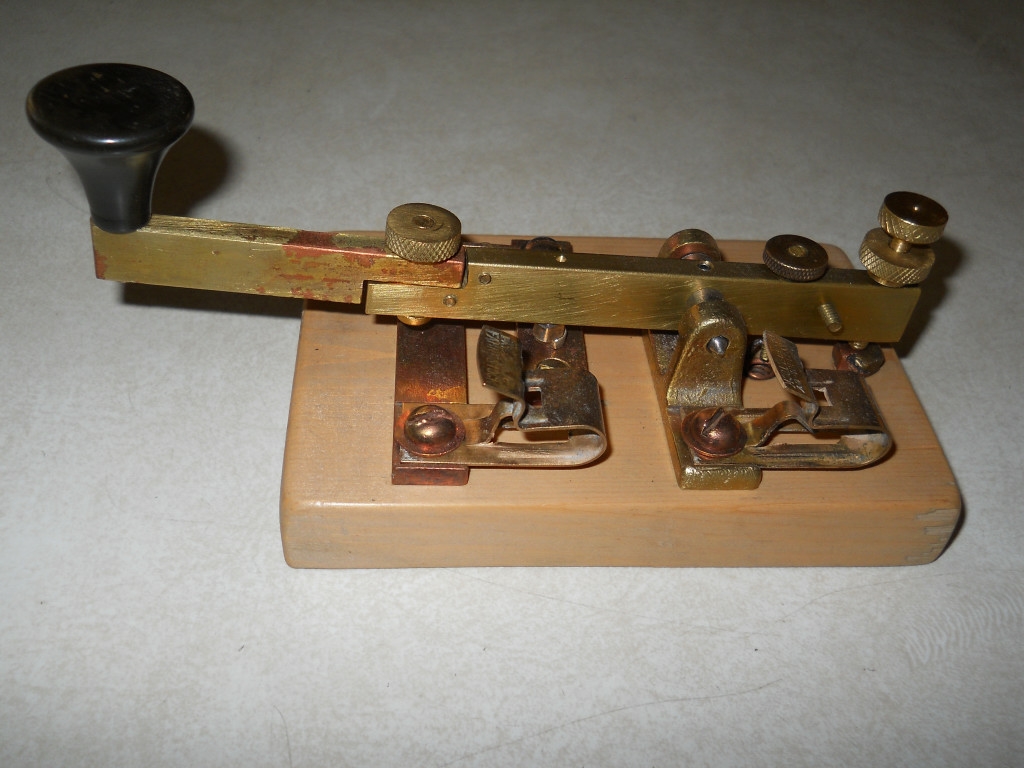
Sept 2015 NS3E Photo
The large Fahnestsock line clips are shown in this photo.
This latest key is a version of the Swedish military type. They all are built basically the same style but differ slightly in manufacturing parts. All Swedish keys are of the pump type and feature the front tab contact points. All have long levers that make for very smooth sending. These keys are beautifully made of quality materials, are a dream to operate, and command a high price on the used marketplace.
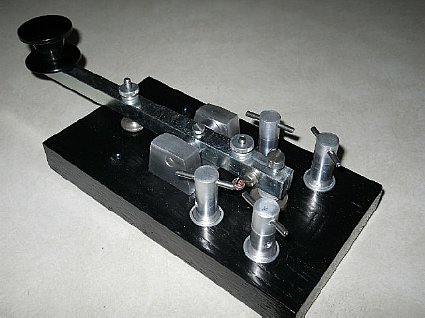
June 2013
Pictured is a reproduction WW2 Japanese naval key. Most all of the WW2 Jap keys were of the English pump type and are very well built with excellent materials. The naval type tends to be larger and a little more robust than the army type. The naval keys usually have a slate base where the army type is wood or plastic. Both types feature the unique "T" line posts. These keys were made to far outlast our cheaper J-37 & J-38.
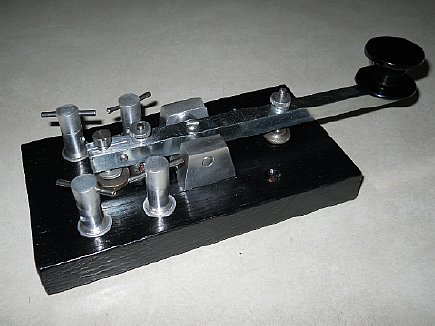
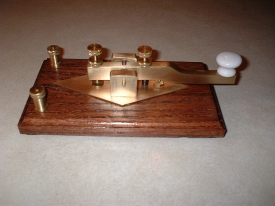
June 2010
Here is the second key that I was telling you about. With minor differences, it is identical to the first (aluminum), but this one of brass. The base is thinner, and the lever is a little thicker. Each key took me a couple of weeks to make (on an on & off basis), And, I spent about 20+ hours on each. It's a labor of love, so time is not important.
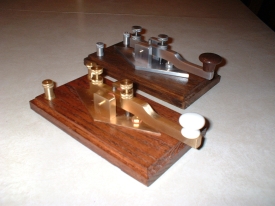
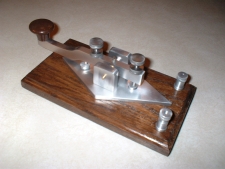 June 2010. The key is made of hardcast aircraft
aluminum and steel. All aluminum parts except the line posts are hand crafted,
and the adjusting screws were made on my lathe and of steel. The line posts
machined out of aluminum also. The diamond shaped base of the key is reminiscent
to the base types of some pre 1900 camelback keys. The basic lever and uprights
are typical English type pump key. The lever itself is lowered in the rear
to mimic the shape of the very early US step-lever keys. The contacts and
return spring are like the basic US Triumph keys.
June 2010. The key is made of hardcast aircraft
aluminum and steel. All aluminum parts except the line posts are hand crafted,
and the adjusting screws were made on my lathe and of steel. The line posts
machined out of aluminum also. The diamond shaped base of the key is reminiscent
to the base types of some pre 1900 camelback keys. The basic lever and uprights
are typical English type pump key. The lever itself is lowered in the rear
to mimic the shape of the very early US step-lever keys. The contacts and
return spring are like the basic US Triumph keys. 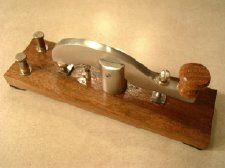 March 2009. This one I call the mini-camelback.
The lever and yolk are hardcast aluminum. Spacing is attained by adjusting
the contact screw and setting it with the lock nut. This saves clutter with
other means of lever travel. Don't think I've seen anybody else do it this
way. Maybe original, Huh?
March 2009. This one I call the mini-camelback.
The lever and yolk are hardcast aluminum. Spacing is attained by adjusting
the contact screw and setting it with the lock nut. This saves clutter with
other means of lever travel. Don't think I've seen anybody else do it this
way. Maybe original, Huh? 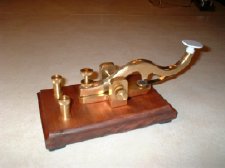
March 2009. This is a reproduction of a Palmer Hallwhich was one of the very first keys appearing in the 1850's. The knob was ivory instead of resin or plastic. The lever, as well, was solid brass. In my reproduction all is brass with the exception of the contacts between the lever and the base. The lever contact is an adjustable set screw, and the base contact is a steel flat headed bolt. I rough cut the base and lever out of a plate of 3/8"brass using an electric hacksaw. Rough shaping was done with a bench grinder and the final shaping was done with hand files. A long, tedious project, but I'm happy with the results.
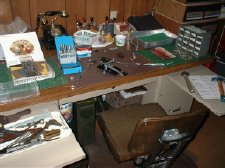
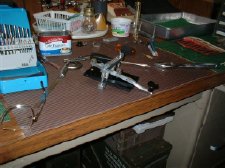 NS3E's final assembly desk.
NS3E's final assembly desk.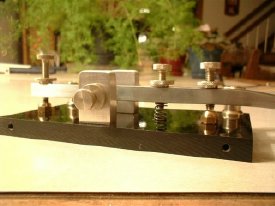 December
2008
December
2008 Pictured key is an original design utilizing NOS key screws and knurled nuts, a 1/4" lever fashioned from steel bar stock, upright yoke posts from hard cast aluminum stock, and a black plastic base from an old relay. This style of key is very light and positive to the touch and several old keys of note are similar. CLICK TO ENLARGE
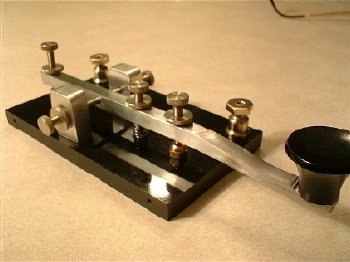
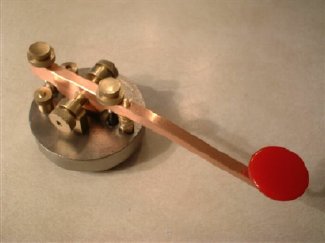 August
2007. Here I am again. The spirit moved me, so I built another key. I had
fun with this one and it works extremely well with perfect feel. As I mentioned
before, a longer lever makes for a softer, more comfortable operation. That
is why the Swedish keys have long lever and are highly prized for their
operation. The base is stainless steel, the lever is copper, and everything
else is brass. I made all the thumb screws and nuts with my lathe. Cut the
lever out of a grounding strip. 73 NS3E
August
2007. Here I am again. The spirit moved me, so I built another key. I had
fun with this one and it works extremely well with perfect feel. As I mentioned
before, a longer lever makes for a softer, more comfortable operation. That
is why the Swedish keys have long lever and are highly prized for their
operation. The base is stainless steel, the lever is copper, and everything
else is brass. I made all the thumb screws and nuts with my lathe. Cut the
lever out of a grounding strip. 73 NS3E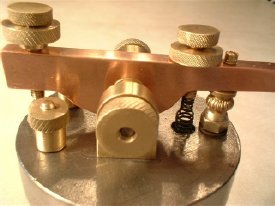
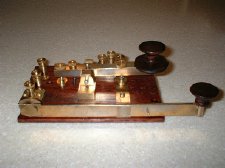 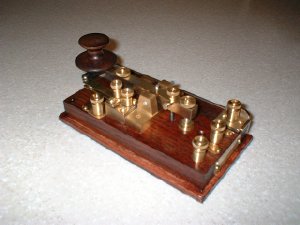 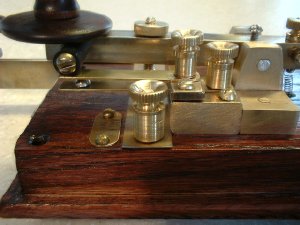
|
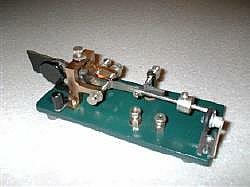
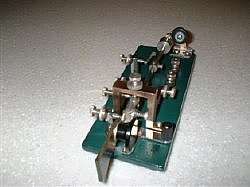
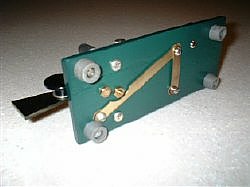 photo
by NS3E
photo
by NS3E
April 6, 2006.The new key is a heavy brass Phelps which is a copy of the famous Civil War"Camelback key." It was hand cut out of a piece of 3/8" brass plate. It is about 1/16th thicker than the original Phelps and thereby heavier. Most keys of the period (Civil War) were quite massive like this one, and some also were 3/8" thick in the base and lever. It is my understanding that even though machinery was involved in the manufacture a lot of the very early keys were tooled quite a bit by hand.
October 6, 2005. "Here is the "Jules Verne" key I was telling you about. The lever is walnut and the front contacts are basically Swedish. If you ever watched any of the Jules Verne movies, you would know that this key would look at home on his submarine, Nautilis, or his airship (Master of the world). Contact is made from the lever spade by wire to the lever tension spring, and over to the right binding post. It has an extremely nice feel."
July 12, 2005. Got a call from Ed, NS3E- - - Ed wanted to stop by to show me something. Since I was working on an old Collins Antenna Coupler that was driving me nuts I welcomed Ed's visit. We sat around the kitchen table and he hands me a bag. I open the bag and pull out this beautiful home brew key .
I carefully hold the key admiring the craftsmanship knowing full well that Ed's shop does not have a layth or mill of any kind. Running my fingers down the polish metal he announces that he made it for me and that the key is a gift. I was taken back . . . I carefully held the key and examined it, turning it over and over . . . Even the bottom of the key was perfect with inlayed wiring. As far as I can remember there have only been three hams that have made me something and Ed is the third one. Hams have given me items but hams that home brew are a little stingy with their time.
Ed names his keys and the name of this particular one is "Battery Cap Key". I believe Ed gets his inspirations for some of his keys at the local flea market, in this case the main yoke of the key is an old antique awning bracket. Thank you Ed for the thought, and your time, and your patience.
This "Battery Cap Key" will be used on my HRO station with the homebrew transmitter.
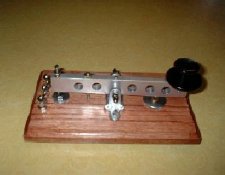
July 27th 2005
"The key is a combination of a turn of the century English pump key, and a turn of the century French Ducretet design. Several of the early French keys had holes drilled in the larger levers. Also, some of the early Italian designs were likewise. I don't presume that it was done to lighten the key because weight in a key is desirable. Maybe it was with the idea that the metal you save out of every 4th or 5th key would be enuff for another? If so, it was a silly way to economize. A lot of the early keys had key down contacts as well as key up contacts. I don't really understand the technology involved, but put them on this key as well. You will notice that I used up the second yoke that I got at Spence's. Maybe I'll be lucky and find a few more." NS3E
"This is a copy
of Brach's WW1 aircraft key #6. I bid on one at
eBay, but knew it would go for bigger bucks. It went for nearly $300,
so I decided to make my own. It's a good copy if you don't look terribly
close."
March 2005
"The small key on the round walnut base is my
own design based on best points of several makes.
Everything is junkbox parts except the red knob."
